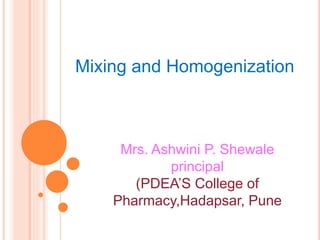This document discusses mixing and homogenization processes. It defines mixing as combining two or more substances together, and identifies perfect mixing as each particle of one material lying adjacent to a particle of the other material. The objectives of mixing are outlined. There are three types of mixtures discussed: positive, negative, and neutral. The mechanisms and equipment used for mixing powders, liquids, and semi-solids are described. Homogenization is defined as preparing a fine emulsion from a coarse one by converting large globules to small globules. Common homogenization equipment like hand homogenizers, Silverson mixers, and colloidal mills are summarized.
















![Mechanism of Mixing for Liquid :
1. Bulk Mixing 2. Turbulent Mixing 3. Laminar Mixing
4. Molecular diffusion.
1) Bulk Mixing: The movement of relatively large portion of
material being mixed from one location to another
location in the system. This is mainly accomplished by
paddles revolving blades or other devices which moves
volume of fluid in different direction.
2) Turbulent Mixing : The phenomenon of turbulent Mixing
is a turbulence flow a fluid which can be characterized by
random fluctuation of fluid velocity at any point within the
system. In the turbulent flow are eddies of various sizes
are developed. [Eddies : An eddy is define as a portion of
fluid moving as a unit in the direction i.e. opposite to that
of the general flow of fluid].It is very effective mixing
mechanism.](https://image.slidesharecdn.com/mixing-191205090059/85/Mixing-17-320.jpg)








































